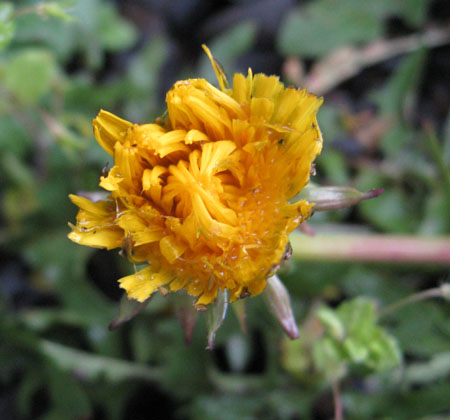
Dandelion
Taraxacum officinale
Asteraceae (Sunflower family)
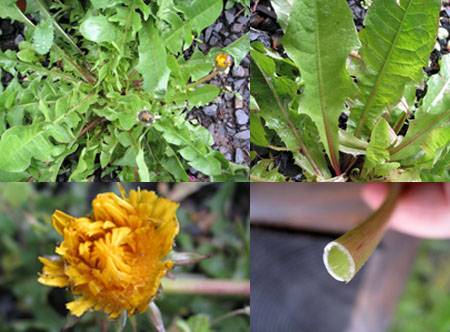
Picture Above: Dandelions
Dandelions are native to Europe but have established themselves around the world. They thrive in moist sites: meadows, lawns, pastures, and most likely in your own garden. It is a perennial herb whose leaves grow in clusters around the root crown and whose long tap roots exude a milky juice.
The dandelion is both a food and a medicine. Its leaves contain a number of nutrients including: iron, zinc, boron, calcium, silicon, and is especially high in potassium. It is also high in vitamins A, B complex, C, and D.
As a food you can add young dandelion leaves to salads, to stir fries, or pasta dishes. It is best to pick the leaves from crowns that have not yet flowered because once the plant flowers the leaves become tougher and more bitter, though you can still eat them if you choose. The root can be dried and then used as a coffee substitute. The flowers have traditionally been used to make wine.
As a medicine the dandelion plant has proved to be one of the safest and best diuretics because, unlike conventional diuretics, it is extremely rich in potassium so that it replaces what the body loses through water elimination. Dandelion is used as a liver and kidney tonic, a digestive stimulant, and is considered a remedy for high blood pressure. The latex contained in the leaves and stalks is used to remove corns.
Every part of the plant is safe to use.
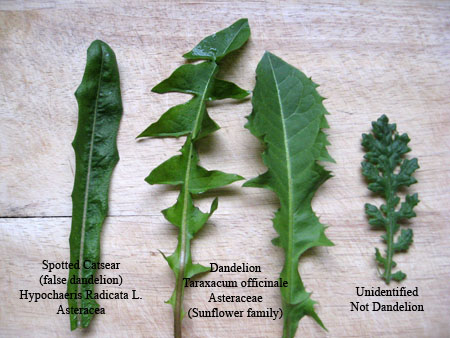
Identifying dandelions in your yard or in wild areas:
Dandelions are not difficult to find and most people know them by sight already. However, if you want to be sure you are collecting the true dandelion, you need to become familiar with its imposters. In the picture above there are 4 leaves. The first one is from a plant often mistaken for dandelion which is why it is commonly referred to as “false dandelion”. The next 2 are both true dandelion leaves. The last one I have yet to identify but it grows everywhere the dandelion does in my garden. Let’s go over the identifying qualities of the dandelion.
Identifying factors of a true dandelion:
The leaves are oblong with a jagged edge. (Think “toothy”)
The leaves grow in a rosette close to the ground.
The stems of the flowers are hollow.
There is only one flower per stem.
The leaves are smooth to the touch.
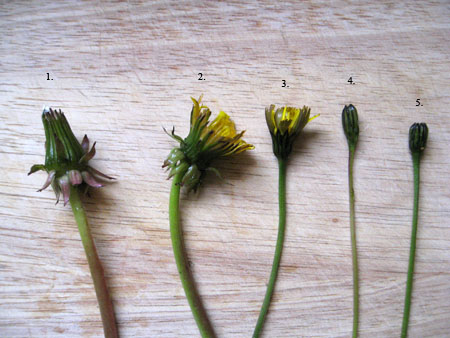
1. closed dandelion bud 2. opening dandelion bud 3. false dandelion semi-open bud 4. false dandelion bud 5. false dandelion bud
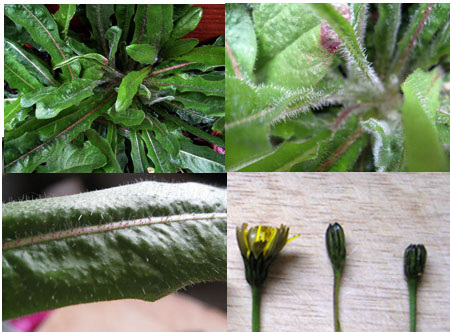
Picture Above: False dandelions
False dandelions grow just as prolifically in most people’s gardens and are easily confused for them if you don’t know a couple of ways to differentiate them from the real thing.
Identifying factors of Spotted catsear (false dandelion):
The leaves are oblong and don’t have a jagged edge.
The stems of the flowers are thin and solid.
The flowers and flower buds are small.
The leaves are prickly both on top and on the underside.
Once you observe the differences between the two you will have no trouble telling them apart. The two most immediately discernable differences are the fuzziness of the leaves of the imposter- true dandelions do not have prickly, fuzzy, or spiny leaves, and the stem of the flower- the true dandelion has a thick hollow stem and its imposter has a thin solid one.
You don’t need to worry about accidentally picking the wrong one to put in your food because although there are some toxic members of the Asteraceae family, all of the dandelion look-alikes in the family are completely harmless.
You can pick the leaves to eat fresh or you can dry them for later use. All parts of the plant are bitter, though the bitterness is much less pronounced in the young leaves. I have eaten them in pasta and I can say that they are bitter but paired with the rich cheese sauce I used the slight bitterness was counteracted nicely.
Dandelions, in most climates, bloom for about nine months out of the year. The best time to harvest young leaves is either in the spring or the fall. The roots can be cut and dried for later use as well.
It is amazing how a plant we have come to regard as an enemy of our yard can be such a boon to our health and well being. Instead of cursing yours or using poison to get rid of them, how about harvesting them to dry for year round use and why not consider making wine with them? This little weed packs a powerful nutritional punch and is worth putting back on our list of revered plants. I don’t generally prefer bitter greens but I have to admit that after doing a bunch of reading about dandelions I feel I have wasted a great deal of time not treating my body to such an easy source of vitamins and minerals. I am teaching my palate some new tricks and I entreat you to join me in the adventure!
Reference Material for this article:
“Weeds Of The West” edited by Tom D. Whitsun
“National Geographic Desk Reference to Nature’s Medicine” by Stephen Foster and Rebecca L. Johnson
“The Complete Herb Book” by Jekka McVicar
“Rosemary Gladstar’s Herbal Recipes for Vibrant Health” by Rosemary Gladstar